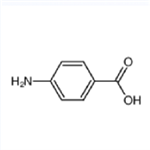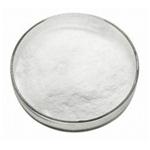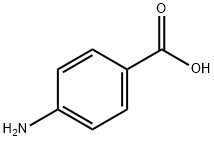Biological activities of 4-aminobenzoic acid
Jul 4,2023
General Description
4-Aminobenzoic acid, also known as p-aminobenzoic acid, is an organic compound with the chemical formula C7H7NO2. It is a white crystalline solid that is slightly soluble in water. PABA is widely found in nature and serves as a precursor for the synthesis of folic acid, which is essential for DNA synthesis and various cellular functions. 4-Aminobenzoic acid has been studied for its biological activities and potential therapeutic applications. Some of its notable biological activities include: antifungal activity, cytotoxicity and acetylcholinesterase inhibitory activity.

Figure 1. 4-Aminobenzoic acid
Biological activity
Antifungal activity
4-Aminobenzoic acid, derived from the secretions of rhizobacterium Lysobacter antibioticus OH13, exhibits a broad range of antifungal activities. The antifungal mode of action of 4-aminobenzoic acid has been elucidated, specifically against the fungal pathogen Colletotrichum fructicola, which causes bitter rot disease in pears. The study indicates that 4-aminobenzoic acid disrupts the fungal cell cycle by inhibiting septation during cell division in C. fructicola. Additionally, stability and diffusion screening experiments have revealed that 4-aminobenzoic acid degrades after 15 days but can penetrate the pear skin and reach the external parts of the mesocarp. In vivo studies further demonstrated the curative effectiveness of 4-aminobenzoic acid against C. fructicola infection in pears. To evaluate the biocontrol efficacy of Lysobacter antibioticus OH13 for bitter rot disease, cultures of OH13 containing 379.4 mg/L 4-aminobenzoic acid were sprayed on inoculated pears, resulting in a significant reduction of pathogen symptoms. Therefore, these findings highlight the promising antifungal activity of 4-aminobenzoic acid and its potential as a valuable strategy for the management of bitter rot disease in pears. 1
Cytotoxicity
4-Aminobenzoic acid and its derivatives have demonstrated diverse biological activities. In a study, a molecular hybridization approach was employed to combine 4-aminobenzoic acid, an essential nutrient for many human pathogens but not for humans, with various aromatic aldehydes such as salicylaldehydes and 5-nitrofurfural, via imine bond formation in a one-step reaction. The resulting Schiff bases were subjected to screening as potential agents with antimicrobial and cytotoxic properties. The chemical modification of non-toxic 4-aminobenzoic acid led to the development of compounds exhibiting antibacterial activity, including inhibition of methicillin-resistant Staphylococcus aureus at minimum inhibitory concentrations (MIC) as low as 15.62 µM. These derivatives also displayed moderate antimycobacterial activity (MIC ≥ 62.5 µM) and potent broad-spectrum antifungal properties (MIC ≥ 7.81 µM). Furthermore, certain Schiff bases exhibited significant cytotoxicity against the cancer cell line HepG2, with IC50 values equal to or greater than 15.0 µM. It is worth noting that the choice of aldehyde used for the derivatization of 4-aminobenzoic acid offers the possibility of fine-tuning specific activities, enabling the development of derivatives with promising bioactivities. In conclusion, these findings demonstrate the cellular toxicity of 4-aminobenzoic acid and its derivatives, highlighting their potential as antimicrobial and cytotoxic agents through the strategic combination of pharmacophores via molecular hybridization. 2
Acetylcholinesterase inhibitory activity
A study has assessed the activity of some derivatives of 4-aminobenzoic acid as acetylcholinesterase inhibitors in vitro. Alzheimer's disease (AD) is known for its progressive decline in memory and cognition, which is associated with a deficiency in the cholinergic system. The main objective of this study is to evaluate the potential of these 4-aminobenzoic acid derivatives to inhibit the activity of acetylcholinesterase. Acetylcholinesterase is an enzyme responsible for the breakdown of the neurotransmitter acetylcholine, which plays a crucial role in memory and cognitive processes. By inhibiting this enzyme, it is possible to enhance cholinergic neurotransmission and potentially alleviate the symptoms of AD. Through in vitro experiments, the researchers will investigate the inhibitory effects of these compounds on acetylcholinesterase activity. The results will provide valuable insights into the potential use of 4-aminobenzoic acid derivatives as acetylcholinesterase inhibitors for the treatment of Alzheimer's disease. 3
Reference
1. Laborda P, Li C, Zhao Y, et al. Antifungal Metabolite p-Aminobenzoic Acid (pABA): Mechanism of Action and Efficacy for the Biocontrol of Pear Bitter Rot Disease. J Agric Food Chem, 2019, 67(8):2157-2165.
2. Krátký M, Konečná K, Janoušek J, et al. 4-Aminobenzoic Acid Derivatives: Converting Folate Precursor to Antimicrobial and Cytotoxic Agents. Biomolecules. 2019;10(1):9.
3. Correa-Basurto J, Alcántara IV, Espinoza-Fonseca LM, Trujillo-Ferrara JG. p-Aminobenzoic acid derivatives as acetylcholinesterase inhibitors. Eur J Med Chem, 2005, 40(7):732-735.
- Related articles
- Related Qustion
- PARA-AMINOBENZOIC ACID (PABA) Nov 12, 2019
PABA is taken by mouth for skin conditions including vitiligo, pemphigus, dermatomyositis, morphea, lymphoblastoma cutis, Peyronie's disease, and scleroderma. PABA is also used to treat infertility in women, arthritis, "tired blood" (anemia
Carbohydrazide and their schiff bases hold profound importance and their potential spans across antibacterial, anticancer, antifungal, anti-inflammatory, and numerous other applications.....
Jul 4,2023APID-(+)-Pantothenic acid calcium salt is the calcium salt of the water-soluble vitamin B5 (pantothenic acid), widely used as an analytical reference standard in various analytical applications.....
Jul 4,2023API4-Aminobenzoic acid
150-13-0You may like
- What is the crystal structure of nickel silicide?
May 21, 2024
- What is the crystal structure of chromium silicide?
May 21, 2024
- Crystal Structure of Tantalum nitride
May 21, 2024
4-Aminobenzoic acid manufacturers
- 4-Aminobenzoic acid
-

- $0.00 / 1kg
- 2024-05-21
- CAS:150-13-0
- Min. Order: 1kg
- Purity: 98.0%min
- Supply Ability: 20tons/month
- 4-Aminobenzoic acid
-

- $100.00 / 1kg
- 2024-05-17
- CAS:150-13-0
- Min. Order: 1kg
- Purity: 99%
- Supply Ability: 20Tons
- 4-Aminobenzoic acid
-

- $5.00 / 1KG
- 2024-05-11
- CAS:150-13-0
- Min. Order: 1KG
- Purity: 99%
- Supply Ability: 20TONS




